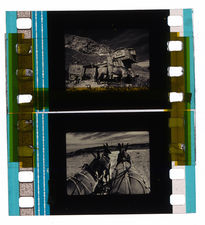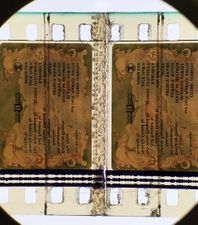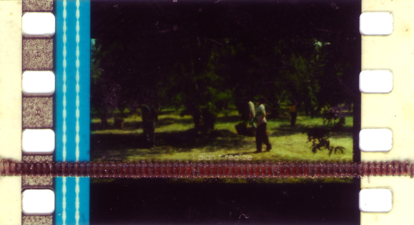| Welcome to Sprocket School! This project is maintained by volunteer editors. Learn more about how this works. |
Splicing: Difference between revisions
Jump to navigation
Jump to search
No edit summary |
No edit summary |
||
| Line 36: | Line 36: | ||
[[Category:Film handling]] | [[Category:Film handling]] | ||
[[Category:Technique]] | [[Category:Technique]] | ||
[[Category: | [[Category: Tools]] | ||
Revision as of 17:35, 4 April 2017
There are a few different methods for splicing two pieces of film together.
- Best splicer and splicing methods for different film gauges and different circumstances
- proper tape removal
- how to redo a splice, how to redo a splice on an archival print
- perforated and non-perforated tape
Tape
- Yellow, white, or zebra tape is often used when building prints for platter or reels larger than 2k feet so that the splice could be easily identified later when the print was broken down. When working with archival prints or making repairs, only ever use clear archival splicing tape. Yellow tape tends to be thinner, and also very hard to remove when left for long periods on a print. NEVER use tapes not meant for splicing such as scotch tape or masking tape!
Making Proper Tape Splices
- Make sure your splices do not show any gaps, the ends of the film should meet perfectly. Gaps can cause the splice to bend at right angles or "hinge" when running through the projector, and the splice may break. A good way to check is the hold the film gently on either side of the splice and bend the film slightly upwards. The film should form a curve, if it makes an angle like a hinge you may need to redo the splice.
Cement
- Cement splices can only be made when working with print of acetate film base
Making Proper Cement Splices
Ultrasonic
- Ultrasonic splices can only be made with prints of polyester (or Estar) film base. They are generally considered permanent splices are should not be removed or redone by a projectionist.
Gallery of Splices
Click to enlarge
-
Yellow "zebra" tape splice
-
Cement splice (messily done) with tape on top
-
Close-up of an ultrasonic splice
Resources
- Splicing tape: Christie's Editorial
- Tape, cement, splicers: Urbanski Film


